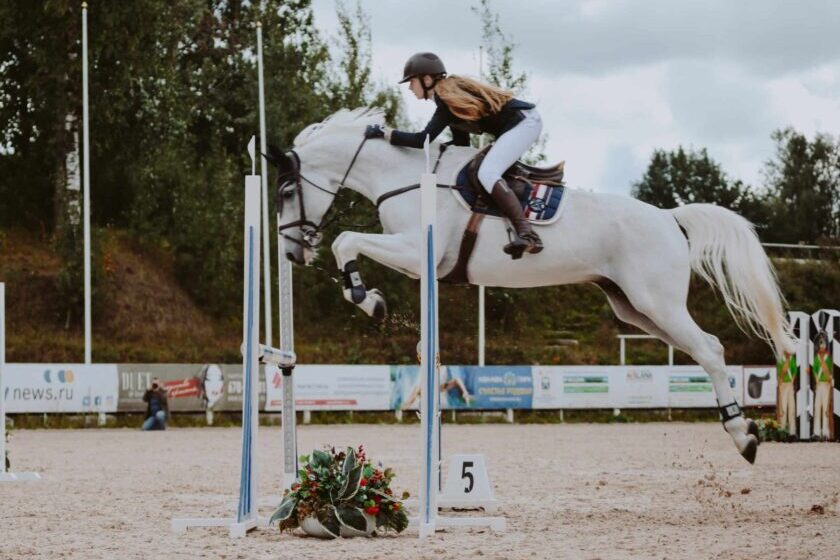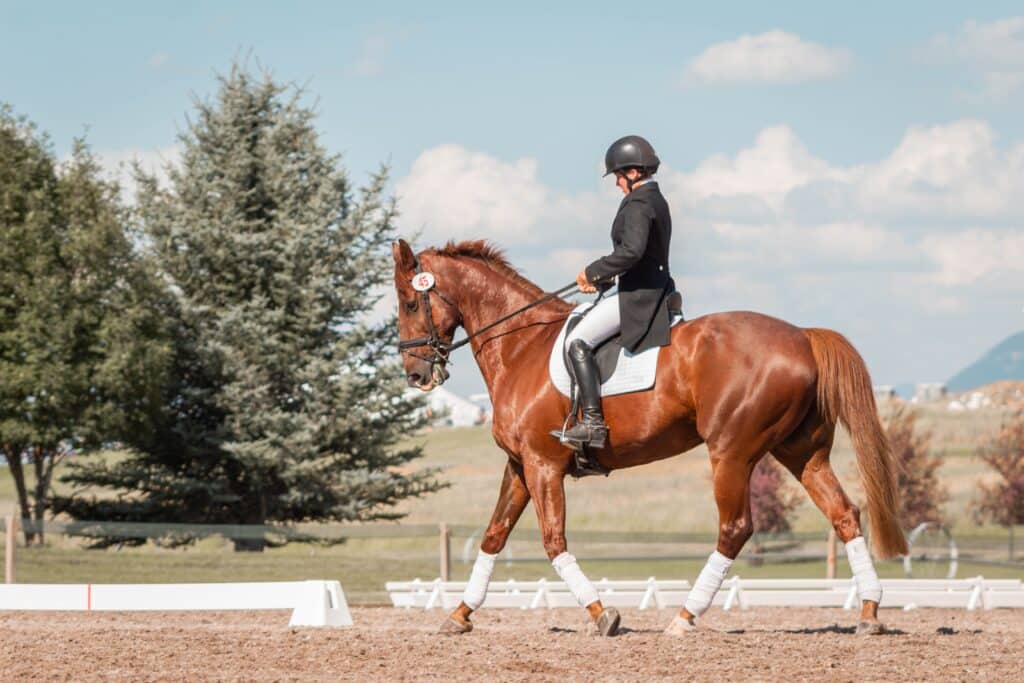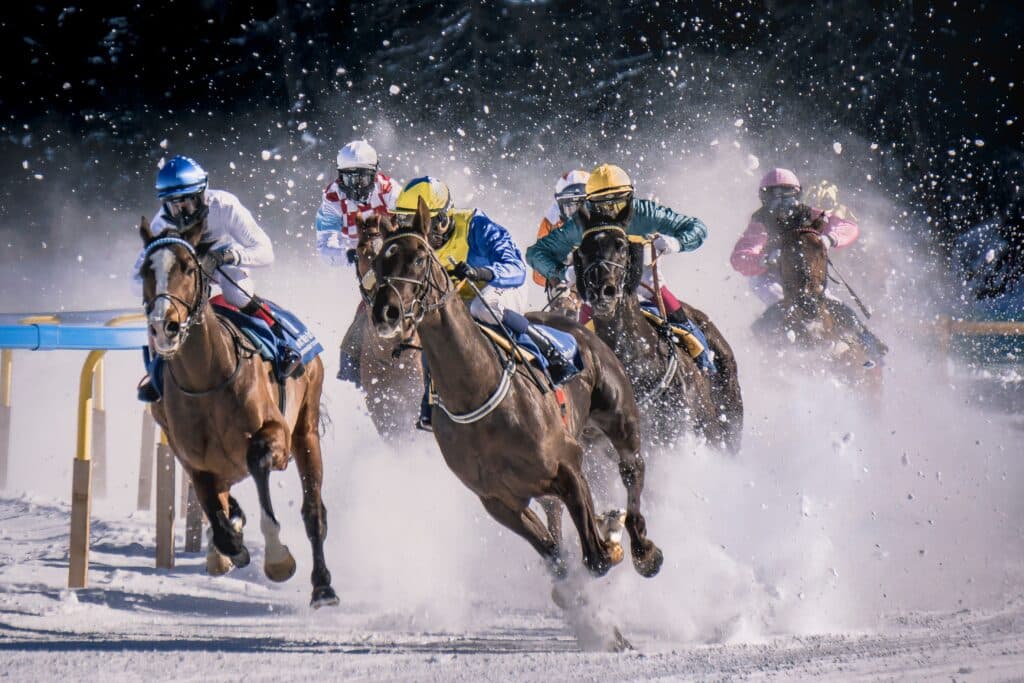Tips and Techniques for Equestrian, Dressage, and Horse Racing Photography
August 11th, 2023
Horses are beautiful, awe-inspiring animals. Horse owners and enthusiasts are passionate about their four-legged friends. Whether striking a statuesque still pose, or perfectly captured in fluid motion, equine photography is a specialty that can be challenging, fun and rewarding for photographers. From casual riders, to equestrian and dressage events, to racing–avid buyers of horse photography can keep a photographer very busy.
This guide will help you understand how to get started in equine photography, some basic facts that set this discipline apart, and a few tips and tricks to make your images stand out.
Getting Started and Types of Equine Photography
Before you start a session, there are a few very important things to remember about horses that set them apart from other types of animals and pets.
Be gentle
Ask the owner, trainer or stable attendant about the horse’s personality and whether the horse has been photographed previously. How have they reacted to camera equipment? Do they have any skittish behavior or bad habits like nipping at strangers? Never stand behind a horse or make sudden movements. If additional light is needed, avoid strobes or other lights that emit quick flashes of light; these can startle a horse. Horses are also sensitive to sound, so be careful not to make loud or sharp noises during your time together. Walk up to them slowly and try to get a sense of the horse’s personality to see if they are sweet-tempered or nervous and fidgety.
Know the Pose
For non-action images, study the horse’s posture and ears, eyes, head and tail positions. Some owners or trainers prefer to see their subject in a certain stance. Ear position is particularly important for some photos – relaxed or upright and alert is generally more desirable than pinned-back, which can be a sign of anxiety. Generally, a horse standing on level ground at 3/4 or full profile, with a foreleg slightly forward and a hind leg back a little, is best for full body equine portraits.

Equine Portraits
Whether horse-only or horse and human, the market for fine art portraits is especially vibrant among this community. The art of perfectly capturing images depicting the relationship between horses and owners or riders is a true treasure. A solo horse portrait can be used to showcase the shape, muscle contours and majesty of the subject for posterity or for promotional, sale, or stud marketing. A horse portrait with their owner or rider can beautifully reflect the personality of both subjects and their relationship. Either type of portrait can be perfect for large prints, holiday cards or photo gifts.
Casual/Lifestyle
Show the horse running around on the ranch, around the stables, in a workout arena, or being groomed. Think about chronicling a “day in the life” editorial-style shoot that shows both posed and candid moments.
Shows and Events
Equine photography taken on location at dressage events and livestock shows during fairs combines aspects of both portraiture and action. Posture of both horse and rider in dressage events is an important aspect of judging. Graceful choreographed movements can be frozen at the winning moment to be appreciated for years to come…right beside the ribbons and trophies.
Equestrian Competition
Another unique and specialized market for equine photography, hunters, jumpers and events are more action than posing with the goal of capturing perfect form while clearing an obstacle in mid-air.
Horse Racing
The crown jewel of horse photography has traditionally been all aspects of the racing business–the stables, tacking up in the paddocks, the procession, pre-during-post race (especially if the winner’s circle is involved). This is big business for horse photographers and presents all the challenges and opportunities of portraits, documentary, and action images at one event.

Equipment for Horse Photography
You might need to adjust your gear bag for the type of horse photographs you plan to shoot. Depending on the size of the event space, portraits might require a different set of lenses than action shots. As with most photo specialties, the lens is probably the most important initial consideration. This gear list is intended for DSLR cameras, but many professional photographers have mastered the ability to snap great images in a pinch with their mobile phone cameras.
For portraits, try a 24-70mm f/2.8 zoom lens. This lens gives you the latitude to go from full body to tighter head and shoulders images, while staying at a safe and respectful distance from the subject. A fixed 50mm or 85mm lens with the ability to stop down to a shallow f/1.8 aperture will give you the ability to shoot some nice depth-of-field portraits with soft background blur. Horses can also look great when photographed with longer 150mm lenses.
To capture more action-oriented shots, a longer telephoto lens is preferable – like a 70-200mm zoom lens – so you can get a tight shot from wherever you are stationed.
For the rest of the necessary gear, it is essentially the same as what you would pack for many other types of photo sessions. Just remember – no flash or metallic reflectors so as to avoid startling the horses.
- Tripod / monopod (particularly helpful when using the zoom lens)
- Lens filter–a uv filter will help keep your lens clean and protected in dusty equine event locations
- Spare memory cards
- Preferred camera strap, halter, or brace
- Batteries and chargers
- Air duster for dusty environments
- Weather protection (recommended for outdoor events)
Something else to consider if you will be shooting portraits is a small shaker or treats for the horse to perk up their ears. Always check with the owner or trainer first before using those.

The Challenges of Horse Event Photography
Besides the unpredictability of the horses, keep in mind that you will typically be in outdoor or arena settings. You should prepare for the weather, sunlight or clouds, natural environments or cluttered backgrounds.
If you can master variable lighting conditions, especially without using flash or reflectors, you will usually come away with pleasing photos. Harsh midday sun can be challenging, since the strong contrast between bright light and dark shadows yields images that require extra post processing steps to ensure a great print. Remember to expose for the highlights in harsh conditions, as it is generally possible to reduce the contrast of shadows in post processing, but blown out highlights are often a lost cause.
Days with moderate to heavy clouds have more even light, helping to reduce shadows–your position in relation to the sun and your subject is still important, though! On cloudy days, it is helpful to shoot with your subject facing the light whenever possible, rather than being backlit in the early and late parts of the day. Early morning or late afternoon warm sunlight can be effective both when used for front lighting on the subject and exposing for the highlights, or backlighting and exposing for the shadows.
Other challenging aspects of horse photography to consider are the venues and fast action of equestrian and racing events. For jumping events, the course is large and your accessibility might be limited. Think about how you can get the shots you want from whatever vantage point you land on. The same goes for racing, during the actual race. Try to make the most of your position, but also be adventurous, quick and adaptable to get the great shots.
Camera Settings and Tips for Horse Event Photography
Equine events are generally fast, so you will need to shoot at shutter speeds of 1/500s or faster. For slower indoor dressage or arena events, a speed of 1/250s might be perfect and you could consider boosting your camera ISO and wider f/2.8 or f/4 aperture for better exposure while working without strobes.
Depending on your camera, take advantage of Auto modes like Aperture or Shutter Priority and Auto Focus to keep images sharp. Every camera is different and some Auto modes might not perform to your liking, so it is best to test these features out before an event and determine if they work for you.
Burst shooting is absolutely necessary for equestrian jumping and horse racing events. A panning action shot can sometimes produce a creative image that also shows the subject well. Set your shutter speed at about 1/30s and track your camera with the subject as it moves while shooting in burst mode. The goal is to capture the horse and rider sharply with a motion-blurred background.
Composition and Framing Horse Event Photos
Earlier, we covered one of the preferred posed stances for full-body horse photos. Besides the 3/4 or full profile portraits, a rule-of-thirds head and shoulders image can beautifully project the personality of a horse. Frame the head at the left or right one-third line and let the shoulders trail off into the remaining two-thirds space, maybe even trailing into a shadow. This makes a pleasing composition and is especially moving if the horse’s eyes are looking at the camera to project its personality.
Look for unique details in a horse’s coat, mane, or tail. Special markings and other traits could possibly be the focus of a distinctive shot. Owners and trainers often have specific details about a horse that they find interesting. Ask them if there’s anything special they think should be captured.
Watch for an emotional connection between horses and owners. Sometimes, you will be lucky enough to catch a moment between the two that is magical. Whether tender, playful or relaxed, to catch these moments you might have to just be ready and wait a while.
Framing action shots at equestrian, dressage or racing events sometimes comes down to the luck of the draw while you’re pressing the shutter in burst or continuous mode. Often, these shots are best when the action is basically centered in the frame, but if you shoot dozens or hundreds of frames you might end up with a few creative compositions.

Strategies for Capturing Engaging Horse Event Images
Remember to look around at dressage, equestrian and racing events. Even though your mission is to focus on the horse and client, there can be a lot of visible emotion in the crowd, in friends or family, or in other horses and owners.
Washing, grooming and tacking up before an event can be great opportunities to take a photo of a horse being primped and preened. Catch the emotion of those attending to the horse for unforgettable moments.
Before a competition event, try to locate the horse’s owner with friends or family in the grandstands. If you’re quick, you might be able to capture the moment the horse wins an event, then spin around and get the owner celebrating. Better yet, assign that task to a second photographer to make sure it’s all covered.
Post-Processing Tips for Horse Event Images
After the shoot, you might need to pay special attention to fixing exposure or focus issues in post-processing. If you get a great shot of your equine subject but there is a lot of background clutter on the ranch, you might need to blur and darken the background to shift visual emphasis. Creative cropping might also help an image go from “ok” to “fantastic.”
Since you are likely shooting outdoors and without the use of flash fill, exposure adjustments might be necessary. Lightroom, Photoshop and other post-processing software can help you correct issues and make your images shine.
Maybe the biggest challenge in post-processing horse photos is the removal of halters. Believe it or not, there are actually filters made for horse photography that help expedite removal after the fact. Current AI tools in photo editing software can also be a huge asset in removing halters or other unwanted details, and filling in the space afterward.
Presenting and Sharing Your Horse Event Photography
Ready…and they’re off! Now your images are ready to show to clients after an event. Online photography website resources like Zenfolio give you the ability to create client or event galleries, then share them for proofing, commenting and even direct ordering.
Images are easy to organize and upload, with multiple options for uploading from desktop or via a LR plugin.
When at an event with a large camera and lens, people might even ask you how to find and purchase your images later. Be sure to bring plenty of business cards with your email, portfolio website address, and social media links like Instagram and Facebook/Meta. Also, bring a sign-up sheet to collect emails from interested parties, or a QR code that links directly to your email list signup. As soon as you have images ready, reach out and let them know your gallery or portfolio website is ready for orders.
Building Your Horse Event Photography Business
Equine communities can be very close-knit and hard to break into. Once you are established as a serious horse photographer, happy clients and referrals are often the best path for growing your business. Be sure you have a clean and easy to navigate portfolio website to share your best work, along with social media accounts so people can find you and become followers.
After getting a few good clients, ask them for testimonials, referrals, and about peripheral associations that you could join to not only support their industry, but also to find new clients. Be ready for potential new clients at equine events. Hand out business cards with your portfolio website and social media accounts, and include a QR code so people can easily find you with their phones and start following you right away.
Saddle Up and Get Going
Horse photography can be very challenging, yet provides a dedicated photographer with steady, lucrative opportunities. Horse owners and enthusiasts are among the most passionate and devoted fans of any sport. Some equine photographers specialize only in portraits–especially for promotion, sale, and stud marketing. Others make their mark with action photography in dressage, equestrian, or racing events.
When you decide to make hay in horse photography, check out Zenfolio for a gorgeous portfolio website with client and event galleries and easy sharing and direct ordering capabilities.



